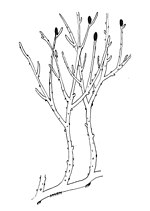Rhynia
|
Rhynia Temporal range: Early Devonian |
|
|---|---|
 |
|
| Reconstruction of Rhynia gwynne-vaughanii, redrawn after Kenrick & Crane (1997:101) | |
| Scientific classification | |
| Kingdom: | Plantae |
| Division: | Tracheophytes |
| Class: | †Rhyniopsida |
| Order: | †Rhyniales |
| Family: | †Rhyniaceae |
| Genus: |
†Rhynia Kidst. & W.H.Lang (1917) |
| Species | |
|
|
Rhynia is a single-species genus of Devonian vascular plants. Rhynia gwynne-vaughanii was the sporophyte generation of a vascular, axial, free-sporing diplohaplontic embryophytic land plant of the Lower Devonian that had anatomical features more advanced than those of the bryophytes. Rhynia gwynne-vaughanii was a member of a sister group to all other eutracheophytes, including modern vascular plants.
Rhynia gwynne-vaughanii was first described as a new species by Robert Kidston and William H. Lang in 1917. The species is known only from the Rhynie chert in Aberdeenshire, Scotland, where it grew in the vicinity of a silica-rich hot spring. Rhynia was a vascular plant, and grew in association with other vascular plants such as Asteroxylon mackei, a probable ancestor of modern clubmosses (Lycopsida), and with pre-vascular plants such as Aglaophyton major, which is interpreted as basal to true vascular plants.
Rhynia is thought to have had lateral branches, which it used to disperse laterally over the substrate and stands of the plant may therefore have been clonal populations.
Evidence of the gametophyte generation of Rhynia has been described in the form of crowded tufts of diminutive stems only a few mm in height, with the form genus name Remyophyton delicatum. Like those of Aglaophyton major,Horneophyton lignieri and Nothia aphylla the gametophytes of Rhynia are dioicous, bearing male and female gametangia (antheridia and archegonia) on different axes. A significant finding is that the axes were vascular, unlike almost all of the gametophytes of modern pteridophytes except for that of Psilotum.
...
Wikipedia
